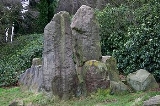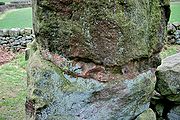
The Bridestones
Encyclopedia
The Bridestones consist of a chambered cairn
, built in the Neolithic
Stone Age
, near Congleton
, Cheshire
, England. It was described in 1764 as being 100 metres long and 11 metres wide; it contained three separate compartments, of which only one remains today. The remaining compartment is 6 metres long by 2.7 metres wide, and consists of vertical stone slabs, divided by a now-broken cross slab. The cairn originally had a stone circle surrounding it, with four portal stones; two of these portal stones still remain. The site is protected as a Scheduled Ancient Monument.
The origin of the cairn's name is unclear. Once legend says that a recently married couple were murdered at the location, and the stones were laid around their grave. Another possibility is that they are named for Brigantia
. Alternatively, the Old English word for "birds" was "briddes"; the stones in their original form could have resembled birds, giving rise to "Briddes stones".
in Mona Antiqua Restaurata.
 The largest single ransacking of the monument was the removal of several hundred tons to construct the nearby turnpike road. Stones from the monument were also taken to build the nearby house and farm; other stones were used in an ornamental garden in Tunstall Park. The holed stone was broken some time before 1854; the top half was found replaced in 1877, but was gone again by 1935.
The largest single ransacking of the monument was the removal of several hundred tons to construct the nearby turnpike road. Stones from the monument were also taken to build the nearby house and farm; other stones were used in an ornamental garden in Tunstall Park. The holed stone was broken some time before 1854; the top half was found replaced in 1877, but was gone again by 1935.
While the southern side of the main chamber was originally a single, 18 feet (5.5 m), it was split in 1843 by a picknicker's bonfire. Of the portal stones, only two remain, one of which is broken and concreted back together. This was reputedly caused by an engineer from the Manchester Ship Canal
, who used the stone to demonstrate a detonator.
Excavations of the site were done by Professor Fleur of Manchester University in 1936 and 1937, with the aim of restoring the site as much as possible to its former condition.
Cairn
Cairn is a term used mainly in the English-speaking world for a man-made pile of stones. It comes from the or . Cairns are found all over the world in uplands, on moorland, on mountaintops, near waterways and on sea cliffs, and also in barren desert and tundra areas...
, built in the Neolithic
Neolithic
The Neolithic Age, Era, or Period, or New Stone Age, was a period in the development of human technology, beginning about 9500 BC in some parts of the Middle East, and later in other parts of the world. It is traditionally considered as the last part of the Stone Age...
Stone Age
Stone Age
The Stone Age is a broad prehistoric period, lasting about 2.5 million years , during which humans and their predecessor species in the genus Homo, as well as the earlier partly contemporary genera Australopithecus and Paranthropus, widely used exclusively stone as their hard material in the...
, near Congleton
Congleton
Congleton is a town and civil parish in the unitary authority of Cheshire East and the ceremonial county of Cheshire, England, on the banks of the River Dane, to the west of the Macclesfield Canal and 21 miles south of Manchester. It has a population of 25,750.-History:The first settlements in...
, Cheshire
Cheshire
Cheshire is a ceremonial county in North West England. Cheshire's county town is the city of Chester, although its largest town is Warrington. Other major towns include Widnes, Congleton, Crewe, Ellesmere Port, Runcorn, Macclesfield, Winsford, Northwich, and Wilmslow...
, England. It was described in 1764 as being 100 metres long and 11 metres wide; it contained three separate compartments, of which only one remains today. The remaining compartment is 6 metres long by 2.7 metres wide, and consists of vertical stone slabs, divided by a now-broken cross slab. The cairn originally had a stone circle surrounding it, with four portal stones; two of these portal stones still remain. The site is protected as a Scheduled Ancient Monument.
The origin of the cairn's name is unclear. Once legend says that a recently married couple were murdered at the location, and the stones were laid around their grave. Another possibility is that they are named for Brigantia
Brigantia (goddess)
Brigantia was a goddess in Celtic religion of Late Antiquity.In the interpretatio Romana, she was equated with Victoria...
. Alternatively, the Old English word for "birds" was "briddes"; the stones in their original form could have resembled birds, giving rise to "Briddes stones".
Condition in 1766
The state of the site was recorded in 1766 by Henry RowlandsHenry Rowlands
Henry Rowlands was the author of Mona Antiqua Restaurata: An Archaeological Discourse on the Antiquities, Natural and Historical, of the Isle of Anglesey, the Antient Seat of the British Druids The Bridestones were among the sites described by Rowlands....
in Mona Antiqua Restaurata.
Subsequent destruction

While the southern side of the main chamber was originally a single, 18 feet (5.5 m), it was split in 1843 by a picknicker's bonfire. Of the portal stones, only two remain, one of which is broken and concreted back together. This was reputedly caused by an engineer from the Manchester Ship Canal
Manchester Ship Canal
The Manchester Ship Canal is a river navigation 36 miles long in the North West of England. Starting at the Mersey Estuary near Liverpool, it generally follows the original routes of the rivers Mersey and Irwell through the historic counties of Cheshire and Lancashire. Several sets of locks lift...
, who used the stone to demonstrate a detonator.
Excavations of the site were done by Professor Fleur of Manchester University in 1936 and 1937, with the aim of restoring the site as much as possible to its former condition.

